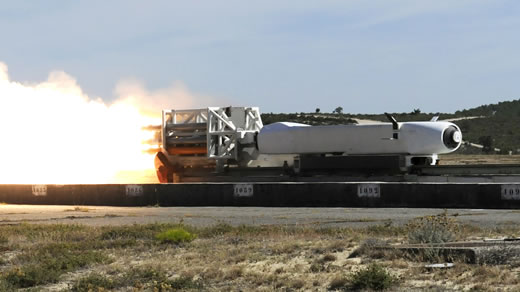

The European missile group MBDA has completed a second successful test of a new aerial weapon designed to penetrate deep buried bunkers. The recent test employed the weapon using representative missile airframe, accelerated on the long sled track at the Biscarrosse test range of DGA Essais de Missiles on 14th September 2010. The first test, carried out on 18th May 2010, evaluated other NGMWS novel concepts. A third and final proving trial is now in the planning, concluding the technology demonstration objectives.
Designated ‘Hard and Deeply Buried Target’ (HARDBUT) is part of the Next Generation Multiple Warhead System (NGMWS) initiative, a research program jointly funded by the defense ministries of France and the U.K., HARDBUT employs a small precursor charge detonated in front of the massive concrete target, perforating an entry path for the hardened penetrating body carrying the main warhead. According to MBDA, During the recent test HARDBUT carried an inert follow through bomb but employed a live precursor charge to demonstrate the penetration capability.
The test proved that the weapon penetration capability significantly exceeds any warhead currently produced by the company. The trial was also designed to assess the robustness of the compact Ruggedized Electronic In-line Fuze (REIF) which will incorporate embedded smart fuzing algorithms. The target and trial set-up were designed to be operationally representative. The first test, carried out on 18th May 2010, evaluated other NGMWS novel concepts. A third and final proving trial is now in the planning, concluding the technology demonstration objectives.
The NGMWS is designed to defeat a wide range of targets such as command and control facilities, infrastructure and underground facilities including caves, reflecting current and potential future operations.
The program is being jointly managed by the UK MoD (DE&S) and the French MoD (DGA), supported by Defence Science and Technology Laboratory (DSTL) and the Commissariat à l’Energie Atomique et aux énergies alternatives, Centre de Gramat (CEA Gramat), and successfully delivered by MBDA teams in the UK and in France, Thales Missile Electronics (TME), QinetiQ, BAE Systems Global Combat Systems Munitions (GCSM) and Fluid Gravity Engineering (FGE). The TDP has previously been independently audited by Cranfield University and assessed as delivering research of a world class standing.
















